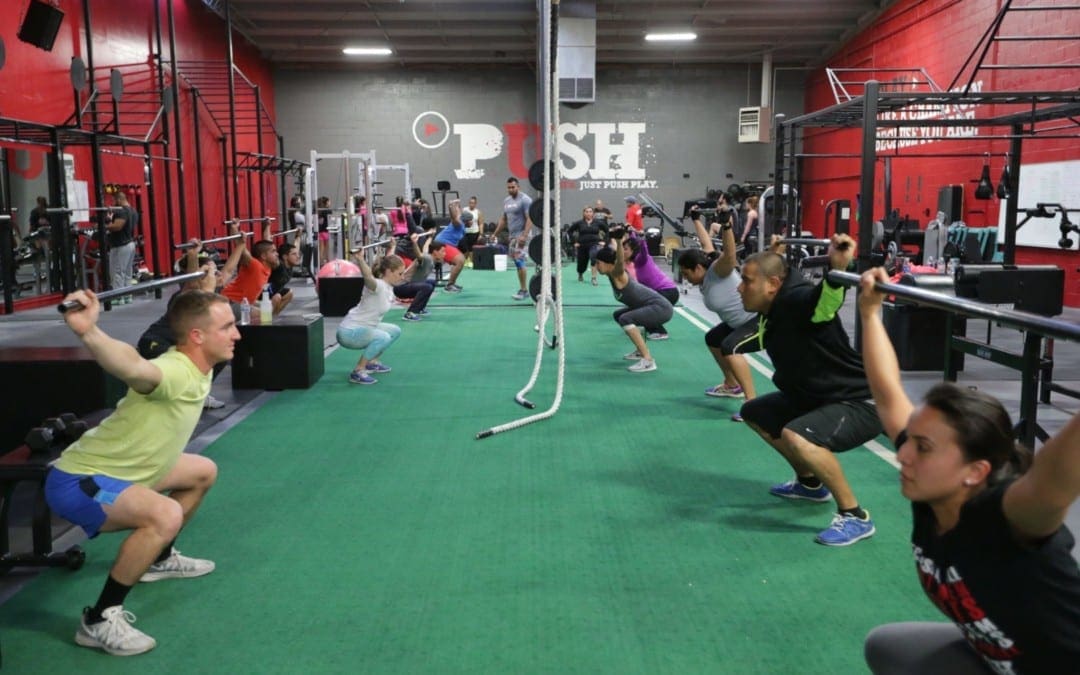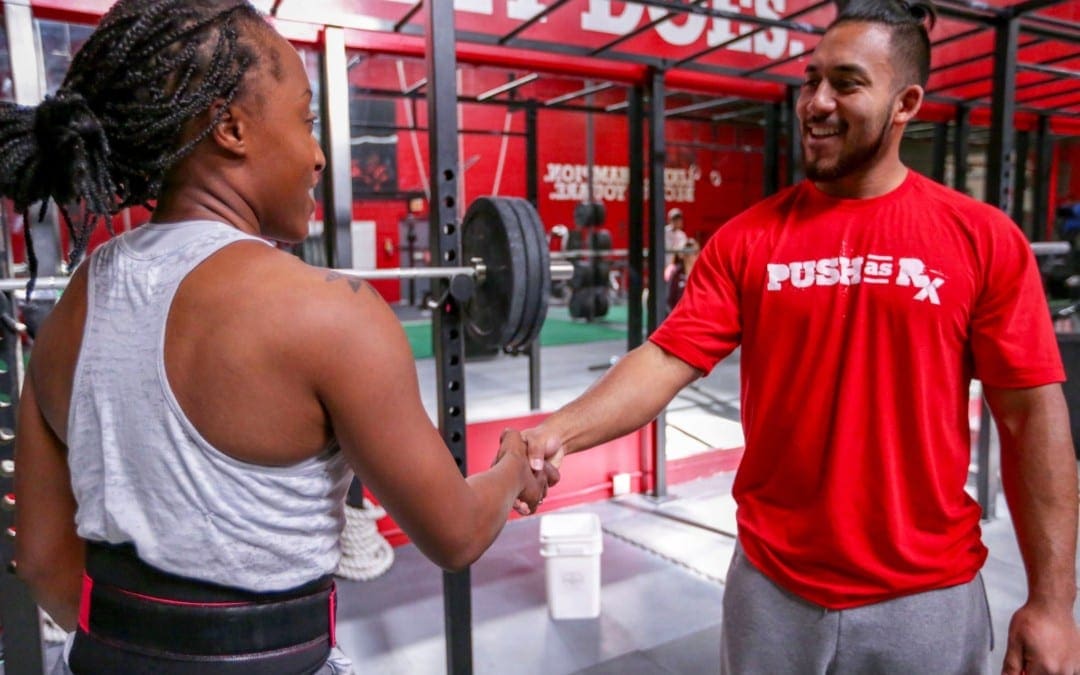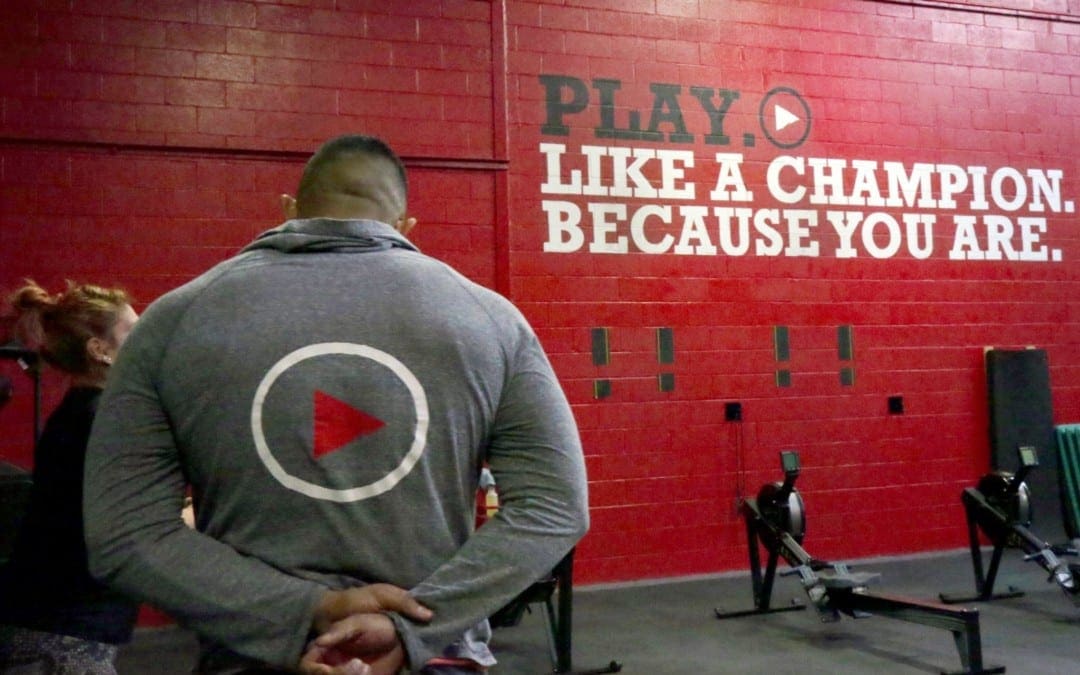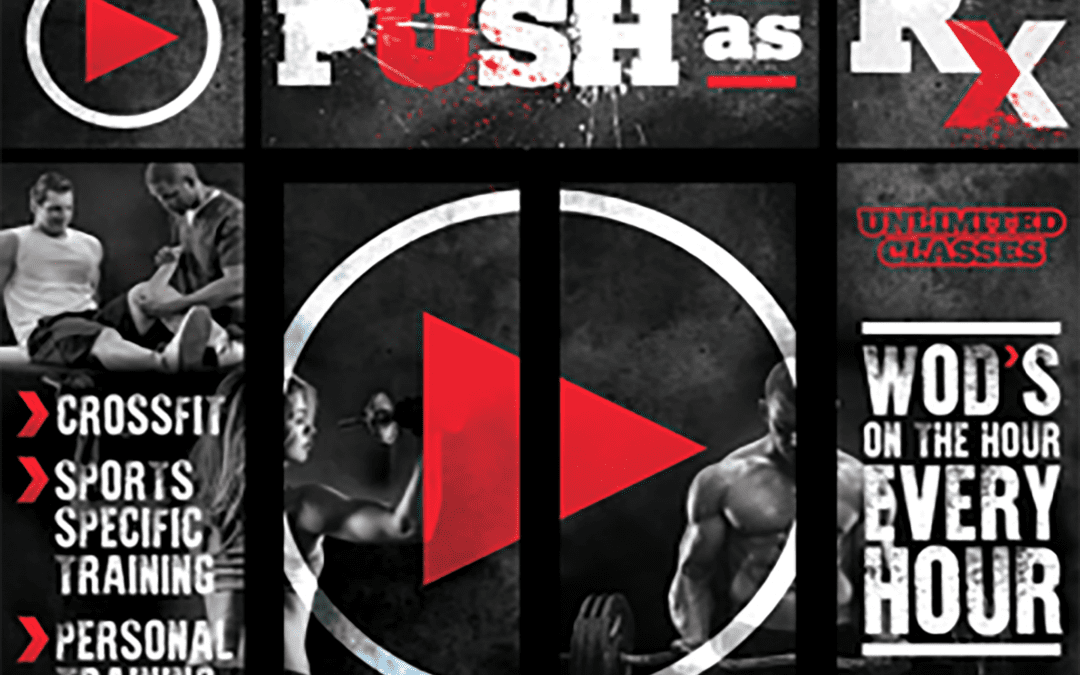PUSH-as-Rx
Optimal Spine and Back Health with PUSH as Rx Fitness & Athletic Training pushes the barriers of average gyms. We believe in committing to change your lifestyle. Blending Crossfit and Personal Training, we can tailor-make workouts that are very specific and individualized to everyone, no matter what shape they’re in.
PUSH as Rx also offers strength and conditioning programs, which improve the athletic ability of kids and teams of any sport at any age. PUSH Kids program uses a combination of skill practice, workouts, and games to build strength and condition children. Our classes include gymnastics, weight lifting, bodyweight movements, running, jump rope, and more.
We are here to support your physical transformation and are happy to steer you in the right direction. We offer nutritional coaching to help our members learn how to fuel their bodies properly. Count on us to design a program to keep you on track and to motivate you every step of the way.

by Dr Alex Jimenez DC, APRN, FNP-BC, CFMP, IFMCP | Crossfit, PUSH-as-Rx
[vc_row][vc_column][vc_column_text]
As a member of PUSH, you will have access to both locations. Each location is operated by different management, so the services offered at the Central and West location vary. The information on this website describes our Central El Paso location.
For more information about the West location, please visit https://www.facebook.com/Push2CrossFit or call (915) 740-2439.
Central El Paso
6440 Gateway East Bldg B,
El Paso, TX 79905
(915) 203-8122
PUSHasRx Central
6440 Gateway East Bldg B,
El Paso, TX 79905
(915) 203-8122
West El Paso
6100 Dew Drive
El Paso, TX 79912
(915) 740-2439
PUSH West
West El Paso
6100 Dew Drive
El Paso, TX 79912
(915) 740-2439

by Dr Alex Jimenez DC, APRN, FNP-BC, CFMP, IFMCP | Crossfit, PUSH-as-Rx
As a PUSH as Rx member, you have access to WODs (workouts of the day) every hour on the hour at our gym. Members have access to showers, making it very convenient for members to join a WOD before work, during lunch, or in between meetings. Our trainers are always available to you to help you improve your technique and help you reach your optimal fitness. Feel free to join the hourly WOD!
For PUSH members, we also offer childcare during certain hours so you can still train even if you have kids! Please call us for more information. We encourage PUSH families to become fit and healthy together, so we always make sure our facility is kid-friendly and safe.
As a PUSH as Rx member, you also have access to chiropractic services with Dr. Jimenez, which can support your fitness goals by ensuring you are pushing your limits safely! Enjoy a first free assessment as a PUSH as Rx member�just stop in any time!
We’ll periodically offer nutrition, flexibility and technique classes to our members at a discounted rate–follow us on Facebook, Twitter, or Instagram for regular updates!
We also offer personal training options at a discounted rate for our PUSH as Rx members�stop in any time to learn more about personal training! We�ll help you move at your own pace to reach your fitness goals.

by Dr Alex Jimenez DC, APRN, FNP-BC, CFMP, IFMCP | Crossfit, PUSH-as-Rx
Let Us Know You�re Coming
It�s important to PLEASE contact us via phone or email�to let us know how you heard about us and if you are new to working out or to CrossFit. This way we can tailor your experience so you get the most out of your training!
Come Prepared
Remember workouts are on the hour ever hour, all day! Please plan to arrive 5-10 mins early for your first class, if you get there after class begins we may not be able to let you train that for that hour. Getting there early allows time for you to fill out a mandatory sign up sheet, meet the coach or coaches for that hour, get acquainted with our awesome gym and of course to warm up before the workout.
Personal Training & Personal Care
PUSH offers six trainers with a wide variety of certifications and backgrounds! Whether you�re interested in personal training, CrossFit, sports-based training, tactical training, leaning out, losing weight, or putting on muscle�we know what to do to help you achieve your goals!

by Dr Alex Jimenez DC, APRN, FNP-BC, CFMP, IFMCP | Crossfit, PUSH-as-Rx
Welcome to PUSH Fitness & Athletic Training
PUSH Fitness & Athletic Training is pushing the barriers of average gyms. Not only do we offer training sessions on the hour every hour but we also cater to the most athletic to the elderly and obesity of populations. We believe in making the commitment to change your lifestyle and not forcing you to.
By blending CrossFit and Personal Training, we are able to tailor make workouts that are very specific and individualized to each member no matter where they are physically. Ultimately PUSH�ing them to feel and look their absolute best.
We don�t stop there. PUSH also offers strength and conditioning programs, which improves the athletic ability of kids and teams of any sport at any age.
PUSH Crossfit
Crossfit is an intensive yet effective core strength & conditioning program. Our programming focuses on functional movement patterns, or, movements that you find in real life – pushing, pulling, squatting, jumping, throwing, carrying, and sprinting.
PUSH Kids
PUSH Kids programming uses a combination of skill practice, workouts and games to build strength and conditioning in children. Our classes include elements of gymnastics, weight lifting, body weight movements, running, jump roping, and more.
Personal Training
We offer personal training services for individuals or small groups that desire highly customized, one on one (or group) fitness instruction at all levels. Count on us to design a program to keep you on track and to motivate you every step of the way.
Nutritional Coaching
What do I eat?�We are here to support your physical transformation, and are happy to steer you in the right direction.�We offer nutritional coaching to help our members learn how to properly fuel their bodies.
Athlete Development
Our training programs are designed for athletes that look to gain a competitive edge in their sport. �We provide sport specific services to help increase an athlete�s performance through mobility,�strength and endurance.
by Dr Alex Jimenez DC, APRN, FNP-BC, CFMP, IFMCP | Crossfit, PUSH-as-Rx
Dr. Jimenez presents a glimpse of Crossfit as is spans across America.
ABOUT two decades ago in California, CrossFit was registered as a trademark by the founder Greg Glassman.
According to nerdfitness.com, CrossFit is a training philosophy that coaches people of all shapes and sizes to improve their physical wellbeing and cardiovascular fitness in a hard-core yet accepting and encouraging environment.
CrossFit workouts change to contain variety to keep its members on its toes. The routine consists of functional movements that aim to increase individual work capacity and is applicable to other sports activities.
More than 324,307 people participated from 175 countries last year. The open game has five workouts over five weeks, which is posted online for the participants to follow.
Every week for the five weeks of the open game, the workout of the day (WOD) is released on Youtube and the official CrossFit website.
CrossFit in Fiji
The Suva Boxing and Fitness gym introduced CrossFit in Fiji last year and entered the open games with only five members.
Napoleon Taumoepeau is the only qualified CrossFit coach in Fiji. He was named the fittest person in Fiji by CrossFit Forging Elite Fitness. CrossFit 679 is Fiji’s only CrossFit affiliate. This year there were 20 members in the CrossFit open game. March 26 was the last of the five workouts at the Suva Boxing and Fitness gym.
CrossFit 679
Determination was on the faces of the participants as they pushed to finish the final WOD of the open games at the Suva Boxing and Fitness gym.
The WOD includes a wide range of physical exercises such as thrusters, squats, pull-ups, sumo deadlift, high pulls and more. CrossFit 679 is a place that has no boundaries and it brings the best out of an individual.
The coach encourages the participants to work hard and never puts one down.
“It may seem intimidating but I have trained many people who have never done CrossFit. Nine out of 10 of them are intimidated but the truth is that CrossFit was designed for all levels of fitness. We, as coaches, are trained to teach someone with little or no knowledge about CrossFit and help them on their way through a new fitness journey,” said Taumoepeau, coach for CrossFit 679.
After every three months, the CrossFit 679 affiliate takes in members who are interested on a journey of learning about CrossFit and the fundamental movements of CrossFit. An introduction seminar is the first step to welcome the participants of CrossFit 679.
To bring the very best during your training for the CrossFit games, proper diet and plenty of water is key.
“When and what you eat plays a big role in how your training will go. We help our CrossFit members to the best of our knowledge to maximise their workouts and it usually starts with diet,” the coach shared.
For the 679 CrossFitter, the CrossFit 679 is a great place to endure the pain and doing so with friendly and motivating people.
“You die but in the best way then cannot wait to die again,” Krystelle Lavaki, one of the participants shared.
CrossFitters diet
CrossFitters normally go on a Paleo diet or a zone diet.
According to Crossfit Impulse, the zone diet isn’t about eating “low-carb” or “high-protein” or anything like that. It’s a diet balanced in protein (lean, natural meats are preferred), carbs (mostly low glycemic-load fruits and vegetables) and fat (one of the most important macronutrients).
With the right balance of protein, carbohydrates and fats, you can control three major hormones generated by the human diet � insulin, glucagon and eicosanoids. The Paleo diet is the healthiest way you can eat because it is the only nutritional approach that works with your genetics to help you stay lean, strong and energetic.

by Dr Alex Jimenez DC, APRN, FNP-BC, CFMP, IFMCP | Fitness, PUSH-as-Rx
Posted on April 14, 2017, 6 a.m. in Diabetes Exercise
Research shows that HIIT quickly improves glucose metabolism and insulin sensitivity in people with type 2 diabetes.
Research published in the Scandinavian Journal of Medicine & Science in Sports shows that high-intensity interval training (HIIT) improves glucose metabolism and insulin sensitivity in people with type 2 diabetes.
The team, from the University of Turku in Finland, was led by Kari Kalliokoski, a senior research fellow.� Jarna Hannukainen served as project manager. In the study, researchers examined the effects of different types of exercise on the body�s ability to process glucose. Twenty-six participants in their 40s and 50s were selected for the two-week trial. One group already had healthy glucose metabolism. The second group included those with type 2 diabetes or pre-diabetes.
In each group, half of the participants were assigned HIIT exercise routines. The other half were assigned moderate intensity exercises. Six training sessions were completed during the two-week period.
At the beginning and end of the study, blood tests were completed that tested participants� glucose and fatty acid uptake. These are measures of how well the body absorbs and processes sugar and fats in the blood stream.
Research Results
In the final data analysis, all participants showed improvement in insulin sensitivity and the ability to metabolize glucose. However, those who completed HIIT workouts displayed a greater improvement than the moderate intensity participants. Researchers point out that any exercise can effectively reduce blood sugar and insulin sensitivity, but HIIT routines produce results more quickly.
HIIT involves performing intense anaerobic activities for a short period, usually 30 seconds. These intense spurts of activity are followed by several minutes of less intense recovery exercises.
Effects on Treatment of Diabetic Conditions
Previous studies have proven a link between regular exercise and improved glucose levels and metabolism. Choosing between HIIT or more moderate activities is a matter of personal preference. It is most important that the workouts be done regularly.
The study�s results support the idea that exercise is a simple, economical, and effective way to treat and prevent diabetic conditions. It also increases patient safety for those with co-occurring conditions, like cardiovascular disease. Exercise reduces the need for medication, which translates into less chance of dangerous drug interactions. Exercise also alleviates some of the less serious physical effects of diabetes, like mental fog and pain in the joints or muscles.
Researchers caution patients to check with their primary physician before starting an exercise routine. The research shows, exercise can lower blood sugar quickly. A person who is taking prescribed medication may need to have their dosage adjusted.
Tanja J. Sj�ros, Marja A. Heiskanen, Kumail K. Motiani, Eliisa L�yttyniemi, Jari-Joonas Eskelinen, Kirsi A. Virtanen, Nina J. Savisto, Olof Solin, Jarna C. Hannukainen, Kari K. Kalliokoski. Increased insulin-stimulated glucose uptake in both leg and arm muscles after sprint interval and moderate intensity training in subjects with Type 2 Diabetes or Prediabetes. Scandinavian Journal of Medicine & Science in Sports, 2017; DOI: 10.1111/sms.12875






















